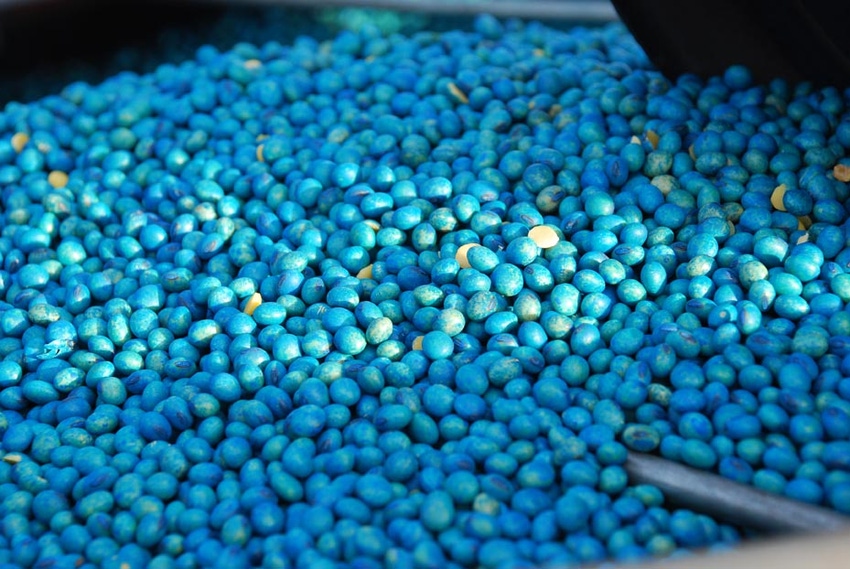February 29, 2012

With soybean commodity prices at record high prices, the number of questions regarding key management considerations also remains high. One of the questions we often receive regards the use of seed treatments, in particular the use of seed treatment fungicides and/or insecticides. Since 2008, we have conducted trials throughout Wisconsin to examine if seed treatments are economically viable for soybean production. In particular, we are most interested in trying to answer the following question: “What is the probability that if I use a seed treatment, the cost of the application is covered?”
Our research trials have been conducted under what we call generation one (2008-2010) and generation two (starting in 2011). The first-generation trials were conducted at nine locations each year, for a total of 27 location-years. Results from these trials were recently published in the journal Crop Science (Esker, P.D., and Conley, S.P. 2012. Probability of yield response and breaking even for soybean seed treatments. Crop Science 52:351-359) and have also been discussed during the past several winter Extension meeting seasons. In this article, we will focus on summarizing those results in some detail.
In our generation-one trials, two seed treatments and an untreated control were examined. They were: ApronMaxx RFC (fludioxonil + mefenoxam) and CruiserMaxx (fludioxonil + mefenoxam + thiamethoxam) (Syngenta Crop Protection, Inc., Greensboro, NC). There were four soybean varieties per location per year and the varieties did differ over years, although within a year, the same varieties were examined at all locations.
In addition to examining the effect of seed treatment and variety on yield, we were very interested in quantifying the probability of breaking even. To do this, we examined different components of cost and expected return. For example, the two seed treatments differ in the cost per unit ($4 for ApronMaxx RFC and $10 for CruiserMaxx, respectively). Also, the observed yield across trial years ranged from 35 to 85 bu./acre so it was important to examine what we might term are “low” (40 bu.), “medium” (60 bu.) and “high” (80 bu.) yield potential environments.
Lastly, it was important to examine these responses across a variety of soybean commodity prices and we started by examining $6, $9 and $12/bu. soybeans. Using the different cost-price structures, we quantified the probability of breaking even based on the percentage increase or decrease in yield with the use of a seed treatment compared to the untreated control.
Trial results
Results from the generation-one trials suggest that the decision to use a fungicide and/or insecticide seed treatment is not a simple yes/no answer. Across the 27 location-years where we tested these products, the relative yield ranged from -6.4% to +11.6% across environments. The relative yield ranged from -3.2 to +7.7% across the seven varieties that were also examined over the course of the study.
Specifically examining the two seed treatments indicated that the probability of at least a breakeven response to the seed treatment was driven by both cost of seed treatment and yield environment. For example, at $6/bu. soybeans and a 40-bu./acre yield environment, the probability that the use of a seed treatment covered the cost the of the application was 42% for ApronMaxx and 3% from CruiserMaxx. As both yield potential and soybean commodity price increased, the probability of covering cost also increased to well over 50%.
How does this translate back to yield though? Across the different relative yield ratios and cost-price structures, the actual increase in yield ranged from 0.6 bu./acre to 2.3 bu./acre. Our original analyses that did not factor the cost-price structures but just focused on yield response were very similar with what we found factoring in the cost-price structures.
How can such information be used? Our experience has been that when spring conditions are cool and wet and when planting date is in late April to early May, the use of seed treatment fungicides are an effective tool, especially given the current value of seed. Additionally, the probabilities we quantified in our generation one trial provide a framework for the grower to improve their understanding of how often they might expect a response over time thus enabling questions such as: (1) holding my seeding rate constant, what does the additional cost per unit for seed that is treated require in terms of yield to maximize the return on investment, and (2) given the increase in cost per unit for seed, can I consider reducing my seeding rate without affecting yield? Lastly growers can use this table to impose their own level of risk to determine the value of a seed a treatment to their own operation.
You May Also Like




